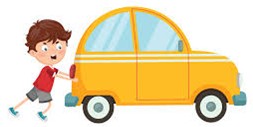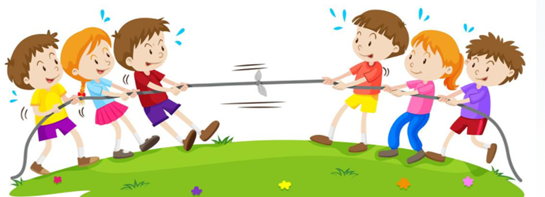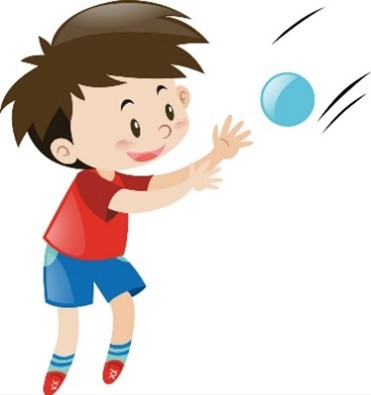May the Forces be with You – Lesson 1 – Sporty Forces
Students develop their understanding of forces by thinking about pushing a car and being in a tug-of-war activity in small groups. These are used to introduce arrows to represent forces. Then students throw and catch different mass balls. Throughout we introduce the language of forces and concepts of mass, distance, time, speed, momentum, acceleration, inertia, and friction.
Introduction: Forces and Arrows One of the most important ideas in the modern world is forces because they make things move. Another important idea is using arrows to represent things. We use arrows in this lesson to represent the strength and direction of student-created forces.
Forces and motion: Because forces make things move, this lesson introduces the language of motion: force, distance, mass, speed, acceleration, deceleration, and momentum (combination of speed and mass). We use a Word Wall for these words.
Pushing a car: Teacher led discussion/optional activity The lesson begins by asking students to visualise pushing a car in the teacher’s car park (we encourage pushing a car if this is permitted). We use this to introduce the language of motion, and we use arrows to represent students individual forces and then to combine them all together. Magnetic arrows, one for each student, let them add their arrows head to tail on the white board and understand the combined arrow as a large force.
Tug-of-war Activity: Small group (5 or 4 students) activity about adding and cancelling forces in a tug-of-war tournament. Students pull against each other in one-on-one tugs, represent the near-cancelling forces with arrows and determine their rank order (see work sheet). Finally they do a 2-on-3 competition to see if the three weakest can beat the two strongest.
Sports activity: throwing, catching and feeling the momentum of heavy and light balls: Small groups work with ping-pong balls and basket balls to reinforce the concepts introduced above by doing simple throwing and catching activities plus a “feeling momentum” activity.
Extension activities in sport: Reinforce student learning by using the newly learned vocabulary in other sport activities.
Review and introduce the next lesson: Identify and review all new words and start the class Word Wall.
Students will:
- know that heat is ‘bundles’ of vibrational energy called phonons
- explain that hotter objects have more phonons that vibrate faster
- use models and analogies to explain the effect of heat on atoms and molecules
- Review the Year 4 May the Forces be with You Lesson 1-4 and 5-8 PowerPoints .
- PrimaryConnections has useful teaching resources for teachers not familiar with word walls and science journals:
- This lesson relates to physical education activities. Every aspect of physical education activities involves application of forces using our muscles. It will be very beneficial if the concepts presented here are incorporated into physical education discussions, especially the language of arrows (see word wall below) and the idea of using arrows to represent forces.
- The website https://kiddo.edu.au/ is an excellent Australian resource for teachers of science who are not able to work with a physical education specialist and may not be familiar with approaches to teaching the fundamental movement skills.
- Students learn the language and ideas of mass, distance, time, speed, momentum, inertia, acceleration, force, friction in the context of their physical skills development lessons in physical education. Students participate in each of the activities and use the ideas and words above to describe the effect of forces in each game.
- Read our ‘Using models and analogies in teaching science’ guide.
- Some physical education equipment will be needed. See equipment list below.
- Ropes for 2–5-person tug-o-war activities – for example skipping ropes.
- Low mass balls and high mass balls. Propose ping pong balls and basketballs and a selection of other low-cost balls of varying mass, including tennis balls (but no golf balls or heavy cricket balls).
- Optional: If the activity is considered appropriate, then a car (with an adult driver for steering and braking) for students to push about 10 meters in the school car park or on a level netball or basketball court.
Start the lesson in the classroom by using the May the Forces be with You PowerPoint to provide an overview of the eight lessons and of the module and outline the Lesson 1 learning intentions.
Explain the importance of using words accurately to describe the effect forces have on objects.
Put up key words on the Word Wall. Use the explanation chart if needed.
- Distance – what is distance? How do you measure it?
- Time – what is time? What units do we use to measure time?
- Speed – who can explain speed? What units are used to measure speed?
- Acceleration – what is acceleration?
- Mass – how many kg are you, how many kg for a car (1500 kg is typical)
- Inertia – which would have most inertia you, the car or the big truck?
- Momentum – Depends on speed and mass. Momentum is bulletiness, it causes damage.
- Arrows – show two things about forces: the strength of the force by its length, and its direction.
After adding key words to the word wall, move onto the next activity.
We will start the lesson with an ‘imagine’ experiment. Who has pushed a car?
This is a ‘pretend’ activity but could be a real activity if a suitable car was available in a safe car park. The idea is to imagine the class is pushing a car in a flat car park. Predict what will happen.

Use creative questioning and encourage all students to contribute answers to what will happen and why will it happen. Follow these steps of activities and questioning with the students.
- Brakes on, all class pushing. What happens if the handbrake is on, so the wheels won’t move? (The car won’t move.)
- Why won’t the car move? – The car won’t move because the brake pads make friction to stop the wheels turning, and the tires have friction on the road. If you pushed hard enough the tires might slide on the road. Has anyone seen black lines on roads where tires have made skid marks?
- Brakes off, one student pushes. Teacher is sitting in the driver’s seat. What happens? Car slowly starts to move and gradually gets faster. (The friction, which is a ‘stopping force’, is removed and the car will start to move. However, its speed will be very slow.)
- More students pushing. Now what happens? Car speeds up faster: this is called acceleration. Why does it speed up faster? (more students, more force).
- Whole class pushes. more force, more acceleration, car speeds up even more. Why? (The car moves faster again because the force pushing the car is much bigger than when there was just one person pushing). Soon everyone has to run to keep up with the car….then they can’t push properly.
- (Imagined) Collision. Imagine pushed the car right across the car park where there was another car parked! What happens when they hit. You have made the car go fast. It has momentum…a combination of speed and mass. It does not want to stop because it has lots of inertia. What sort of damage might it do? Why? (Because it takes lots of force to make a car stop quickly, and that force is enough to dent both of the cars!).
- Pushing a big brick truck What if it wasn’t a car but a fully loaded brick truck? (It would speed up much slower.)
Pushing and the maths of arrows. Each student’s force is shown as one magnetic arrow on the white board. Let’s do an arrow for the whole class pushing: every child should add their arrow on the white board. (Arrows must be put head to tail) until there is a huge arrow.
Teacher Introduction
Tug of War is about forces and friction. You pull with your muscles. Friction stops you from sliding on the ground and stops the rope from sliding through your hands. The friction force must be more than the pulling force or else you will slip and slide.

Arrows demonstration
Ask two students to demonstrate a two-person tug-of-war in front of the white board. Each person’s pulling force is represented by an arrow drawn on the white board.
Draw arrows to represent the forces each student applies. First pulling gently, then stronger. The arrows show the pull direction. They are equal until one person starts to move. Then the winner’s arrow must be longest, the loser’s is shorter. If a person easily wins, their arrow is much longer. If it’s a close match, then the arrows are nearly equal.
Friction discussion: What is friction? It is the force for making things slide. Friction between hand and rope, Friction between feet and the ground.
Size and strength: Does being bigger help? Bigger and heavier always helps in a tug-of-war. It doesn’t matter if your arrow is the biggest or the smallest.
Class tug-of-war
Conduct a whole class tug-of-war. This activity could be done during physical activity time, tall team vs short team, gloves on vs gloves off, shoes on vs shoes off etc..
In preparation for the third part of this lesson the teacher leads a discussion based on the following questions. (Write key concepts on the white board)
- What is the difference between throwing a ping pong ball and a basketball? (Basketball is heavy, needs more force to speed it up)
- What determines how high you can throw each ball? (For the ping-pong ball, height depends on the speed you can move your hand, for basketball depends on the force you can exert.)
- What if you were to throw a balloon: why won’t it go far? (The wind or air resistance.)
- What sized ball do you think you could throw the highest? (The basketball limited by its weight, ping-pong ball by wind resistance…something in between like a tennis ball may the best)
- Suppose you had a very heavy glove on your hand. Could you throw as high as before? Why not? (Now you have to speed up the glove as well as your hand, that is like speeding up the rolling car…you have just added mass, your hand may not get up to speed.)
- What could you do to make the balls go higher? (Use a bat or a racket because the end of a long thing can go much faster than your hand and you can transfer energy from the bat to the ball.)
- Why do cricket and baseball batters wear helmets with face shields? (If they missed the ball it could severely damage their face and head.)
Watch the brief video of a person catching a fast cricket ball. See how the catcher moves their arms to absorb the impact.
Throwing Activity
Choose a location where there is a building or a tree to use to judge the height that the balls go (e.g., top of roof, second floor veranda, second branch on the tree)
Students take turns in being throwers, catchers and observer/recorders. Each student takes turns throwing a ping-pong ball and a basketball vertically upwards. The catchers try to catch them.
Use results to predict what type of ball you could throw highest. Then ask your teacher if you can select some balls to test the prediction.
Have the students complete this group work sheet. Complete a table with list of people, type of ball and rough height estimate.

Catching activity
In small groups form a circle for throwing and catching. How do you change your actions according to the mass and speed of the ball?
Observe carefully how you need to catch a basketball compared with a ping pong ball. For the basketball you have to remember it has much more momentum due to its mass and you need to move your hands in the direction of the ball until it stops. The same is true when you catch a cricket or baseball that is moving very fast. Discuss observations in the group, repeat activity so everyone can see. Record results on worksheet.
Impact Activity
In pairs, take turns in throwing balls gently at each other’s back. Feel the impact. Guess what sort of ball it was. Describe what it feels like for fast and slow balls of different types.
Review and introduce the next lesson
Review the new words for the May the Forces be with You Word Wall. Explain that in Lesson 2 we will make a force measurer and learn about how we measure forces.
Optional Extension: Continually reinforce concepts
Everything we do involves forces. When students learn or practice new skills, ask them to think about the forces they have to apply, where these forces come from and the effect they have. Questions could include:
- What forces are involved in this skill?
- Which muscles are you using to make the forces?
- How to you move your body to help make the forces larger?
- What arrows can you use to show the forces?
These questions could be applied to almost any physical activity: running; hopping; skipping; kicking; balancing; dodging; soccer or basketball dribbling.
The Kiddo website at https://kiddo.edu.au/skills is an excellent resource to support students, classroom teacher physical education specialist, parents and community coaches with details of how to perform the skills listed.
Optional Extension: Tug-of-war tournament
Students need to be in groups of five (4 is OK), each group has a rope, and a clipboard with worksheet for recording arrows for their forces. If they are balanced the two arrows are equal. If one side wins then the winners arrow is longer than the other. Students test each other in pairs.
The following points will be helpful in conducting the activity:
- Note: Only the relative arrow length is important because we are not measuring, just comparing. Draw two arrows, one for each direction. If balanced the arrows are equal, if one person wins their arrow is longer.
- The challenge is to make a list of force arrow from the strongest to the weakest.
- Finish with combined teams such as a 3-team against a 2-team. (two strongest against 3 weakest). Can the 3-team beat the two team?
- Students draw in the combined arrows. Are the three shortest arrows greater or less than the two longest arrows.
- The following two pages have a recording worksheet and sample of completed worksheet.
The recording sheet may be useful in helping students record results. A completed example can be found here.
Atom*: Building blocks of all matter.
Molecule*: Two or more atoms held together by electric forces.
Vibration: Moving backwards and forwards, often about a fixed position.
Photons (if introduced): Individual ‘packets’ or ‘bundles’ of light or other electromagnetic radiation that carry energy and can travel through a vacuum.
Phonons: Bundles of vibrational heat energy in materials.
Solid: A solid is something which has a fixed shape and size or volume because its atoms and molecules are held closely together in fixed positions by strong electric forces. The atoms and molecules vibrate about their fixed positions.
Liquid: A liquid is something which has a fixed size or volume because the atoms and molecules are held closely together but its shape changes because its atoms and molecules are free to ‘mingle’ amongst one another because the the atoms and molecules are vibrating and jiggling too strongly for the forces between then to hold them in place.
Gas: A gas is something in which the atoms and molecules spread out and fill the container it is in because the atoms and molecules have vibrated and jiggled so strongly that they can break completely free from each other.
The following diagram provides a visual model of solids, liquids, and gases:
https://www.sciencelearn.org.nz/images/1839-three-states-of-matter
Model: Scientists use models to help understand the nature of the natural world. Models help us visualize or picture in our mind what something is like that is difficult or impossible to see. Models use familiar objects to represent these things that are difficult or impossible to see. A model can be a diagram or drawing such as the above example, a physical object (like a Nerf gun bullet), or a mathematical relationship (e.g., speed is distance travelled divided by time taken).
*Review from Atom Frenzy
